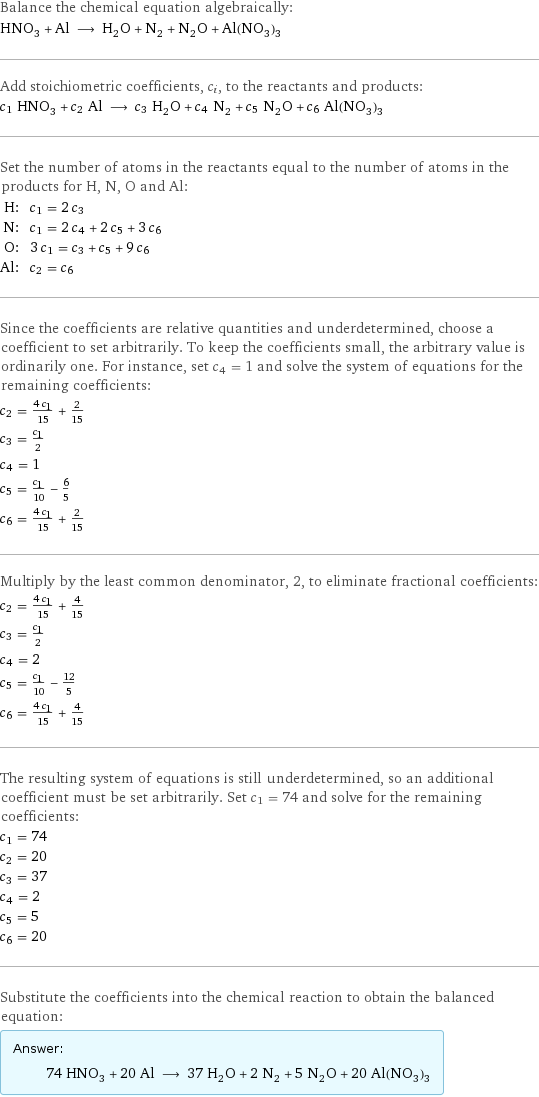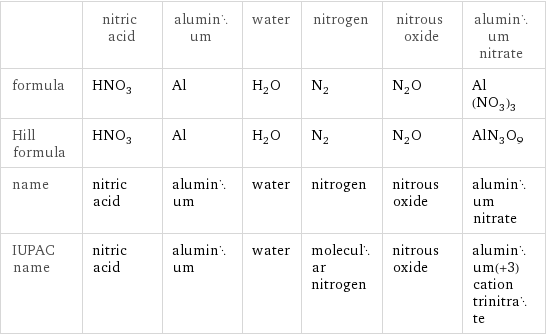Input interpretation

HNO_3 nitric acid + Al aluminum ⟶ H_2O water + N_2 nitrogen + N_2O nitrous oxide + Al(NO_3)_3 aluminum nitrate
Balanced equation

Balance the chemical equation algebraically: HNO_3 + Al ⟶ H_2O + N_2 + N_2O + Al(NO_3)_3 Add stoichiometric coefficients, c_i, to the reactants and products: c_1 HNO_3 + c_2 Al ⟶ c_3 H_2O + c_4 N_2 + c_5 N_2O + c_6 Al(NO_3)_3 Set the number of atoms in the reactants equal to the number of atoms in the products for H, N, O and Al: H: | c_1 = 2 c_3 N: | c_1 = 2 c_4 + 2 c_5 + 3 c_6 O: | 3 c_1 = c_3 + c_5 + 9 c_6 Al: | c_2 = c_6 Since the coefficients are relative quantities and underdetermined, choose a coefficient to set arbitrarily. To keep the coefficients small, the arbitrary value is ordinarily one. For instance, set c_4 = 1 and solve the system of equations for the remaining coefficients: c_2 = (4 c_1)/15 + 2/15 c_3 = c_1/2 c_4 = 1 c_5 = c_1/10 - 6/5 c_6 = (4 c_1)/15 + 2/15 Multiply by the least common denominator, 2, to eliminate fractional coefficients: c_2 = (4 c_1)/15 + 4/15 c_3 = c_1/2 c_4 = 2 c_5 = c_1/10 - 12/5 c_6 = (4 c_1)/15 + 4/15 The resulting system of equations is still underdetermined, so an additional coefficient must be set arbitrarily. Set c_1 = 74 and solve for the remaining coefficients: c_1 = 74 c_2 = 20 c_3 = 37 c_4 = 2 c_5 = 5 c_6 = 20 Substitute the coefficients into the chemical reaction to obtain the balanced equation: Answer: | | 74 HNO_3 + 20 Al ⟶ 37 H_2O + 2 N_2 + 5 N_2O + 20 Al(NO_3)_3
Structures

+ ⟶ + + +
Names

nitric acid + aluminum ⟶ water + nitrogen + nitrous oxide + aluminum nitrate
Equilibrium constant
![Construct the equilibrium constant, K, expression for: HNO_3 + Al ⟶ H_2O + N_2 + N_2O + Al(NO_3)_3 Plan: • Balance the chemical equation. • Determine the stoichiometric numbers. • Assemble the activity expression for each chemical species. • Use the activity expressions to build the equilibrium constant expression. Write the balanced chemical equation: 74 HNO_3 + 20 Al ⟶ 37 H_2O + 2 N_2 + 5 N_2O + 20 Al(NO_3)_3 Assign stoichiometric numbers, ν_i, using the stoichiometric coefficients, c_i, from the balanced chemical equation in the following manner: ν_i = -c_i for reactants and ν_i = c_i for products: chemical species | c_i | ν_i HNO_3 | 74 | -74 Al | 20 | -20 H_2O | 37 | 37 N_2 | 2 | 2 N_2O | 5 | 5 Al(NO_3)_3 | 20 | 20 Assemble the activity expressions accounting for the state of matter and ν_i: chemical species | c_i | ν_i | activity expression HNO_3 | 74 | -74 | ([HNO3])^(-74) Al | 20 | -20 | ([Al])^(-20) H_2O | 37 | 37 | ([H2O])^37 N_2 | 2 | 2 | ([N2])^2 N_2O | 5 | 5 | ([N2O])^5 Al(NO_3)_3 | 20 | 20 | ([Al(NO3)3])^20 The equilibrium constant symbol in the concentration basis is: K_c Mulitply the activity expressions to arrive at the K_c expression: Answer: | | K_c = ([HNO3])^(-74) ([Al])^(-20) ([H2O])^37 ([N2])^2 ([N2O])^5 ([Al(NO3)3])^20 = (([H2O])^37 ([N2])^2 ([N2O])^5 ([Al(NO3)3])^20)/(([HNO3])^74 ([Al])^20)](../image_source/7c9941140c463d23e065cb2433a79a23.png)
Construct the equilibrium constant, K, expression for: HNO_3 + Al ⟶ H_2O + N_2 + N_2O + Al(NO_3)_3 Plan: • Balance the chemical equation. • Determine the stoichiometric numbers. • Assemble the activity expression for each chemical species. • Use the activity expressions to build the equilibrium constant expression. Write the balanced chemical equation: 74 HNO_3 + 20 Al ⟶ 37 H_2O + 2 N_2 + 5 N_2O + 20 Al(NO_3)_3 Assign stoichiometric numbers, ν_i, using the stoichiometric coefficients, c_i, from the balanced chemical equation in the following manner: ν_i = -c_i for reactants and ν_i = c_i for products: chemical species | c_i | ν_i HNO_3 | 74 | -74 Al | 20 | -20 H_2O | 37 | 37 N_2 | 2 | 2 N_2O | 5 | 5 Al(NO_3)_3 | 20 | 20 Assemble the activity expressions accounting for the state of matter and ν_i: chemical species | c_i | ν_i | activity expression HNO_3 | 74 | -74 | ([HNO3])^(-74) Al | 20 | -20 | ([Al])^(-20) H_2O | 37 | 37 | ([H2O])^37 N_2 | 2 | 2 | ([N2])^2 N_2O | 5 | 5 | ([N2O])^5 Al(NO_3)_3 | 20 | 20 | ([Al(NO3)3])^20 The equilibrium constant symbol in the concentration basis is: K_c Mulitply the activity expressions to arrive at the K_c expression: Answer: | | K_c = ([HNO3])^(-74) ([Al])^(-20) ([H2O])^37 ([N2])^2 ([N2O])^5 ([Al(NO3)3])^20 = (([H2O])^37 ([N2])^2 ([N2O])^5 ([Al(NO3)3])^20)/(([HNO3])^74 ([Al])^20)
Rate of reaction
![Construct the rate of reaction expression for: HNO_3 + Al ⟶ H_2O + N_2 + N_2O + Al(NO_3)_3 Plan: • Balance the chemical equation. • Determine the stoichiometric numbers. • Assemble the rate term for each chemical species. • Write the rate of reaction expression. Write the balanced chemical equation: 74 HNO_3 + 20 Al ⟶ 37 H_2O + 2 N_2 + 5 N_2O + 20 Al(NO_3)_3 Assign stoichiometric numbers, ν_i, using the stoichiometric coefficients, c_i, from the balanced chemical equation in the following manner: ν_i = -c_i for reactants and ν_i = c_i for products: chemical species | c_i | ν_i HNO_3 | 74 | -74 Al | 20 | -20 H_2O | 37 | 37 N_2 | 2 | 2 N_2O | 5 | 5 Al(NO_3)_3 | 20 | 20 The rate term for each chemical species, B_i, is 1/ν_i(Δ[B_i])/(Δt) where [B_i] is the amount concentration and t is time: chemical species | c_i | ν_i | rate term HNO_3 | 74 | -74 | -1/74 (Δ[HNO3])/(Δt) Al | 20 | -20 | -1/20 (Δ[Al])/(Δt) H_2O | 37 | 37 | 1/37 (Δ[H2O])/(Δt) N_2 | 2 | 2 | 1/2 (Δ[N2])/(Δt) N_2O | 5 | 5 | 1/5 (Δ[N2O])/(Δt) Al(NO_3)_3 | 20 | 20 | 1/20 (Δ[Al(NO3)3])/(Δt) (for infinitesimal rate of change, replace Δ with d) Set the rate terms equal to each other to arrive at the rate expression: Answer: | | rate = -1/74 (Δ[HNO3])/(Δt) = -1/20 (Δ[Al])/(Δt) = 1/37 (Δ[H2O])/(Δt) = 1/2 (Δ[N2])/(Δt) = 1/5 (Δ[N2O])/(Δt) = 1/20 (Δ[Al(NO3)3])/(Δt) (assuming constant volume and no accumulation of intermediates or side products)](../image_source/2cd1346b4ba8fc29348b8514be79b2f7.png)
Construct the rate of reaction expression for: HNO_3 + Al ⟶ H_2O + N_2 + N_2O + Al(NO_3)_3 Plan: • Balance the chemical equation. • Determine the stoichiometric numbers. • Assemble the rate term for each chemical species. • Write the rate of reaction expression. Write the balanced chemical equation: 74 HNO_3 + 20 Al ⟶ 37 H_2O + 2 N_2 + 5 N_2O + 20 Al(NO_3)_3 Assign stoichiometric numbers, ν_i, using the stoichiometric coefficients, c_i, from the balanced chemical equation in the following manner: ν_i = -c_i for reactants and ν_i = c_i for products: chemical species | c_i | ν_i HNO_3 | 74 | -74 Al | 20 | -20 H_2O | 37 | 37 N_2 | 2 | 2 N_2O | 5 | 5 Al(NO_3)_3 | 20 | 20 The rate term for each chemical species, B_i, is 1/ν_i(Δ[B_i])/(Δt) where [B_i] is the amount concentration and t is time: chemical species | c_i | ν_i | rate term HNO_3 | 74 | -74 | -1/74 (Δ[HNO3])/(Δt) Al | 20 | -20 | -1/20 (Δ[Al])/(Δt) H_2O | 37 | 37 | 1/37 (Δ[H2O])/(Δt) N_2 | 2 | 2 | 1/2 (Δ[N2])/(Δt) N_2O | 5 | 5 | 1/5 (Δ[N2O])/(Δt) Al(NO_3)_3 | 20 | 20 | 1/20 (Δ[Al(NO3)3])/(Δt) (for infinitesimal rate of change, replace Δ with d) Set the rate terms equal to each other to arrive at the rate expression: Answer: | | rate = -1/74 (Δ[HNO3])/(Δt) = -1/20 (Δ[Al])/(Δt) = 1/37 (Δ[H2O])/(Δt) = 1/2 (Δ[N2])/(Δt) = 1/5 (Δ[N2O])/(Δt) = 1/20 (Δ[Al(NO3)3])/(Δt) (assuming constant volume and no accumulation of intermediates or side products)
Chemical names and formulas

| nitric acid | aluminum | water | nitrogen | nitrous oxide | aluminum nitrate formula | HNO_3 | Al | H_2O | N_2 | N_2O | Al(NO_3)_3 Hill formula | HNO_3 | Al | H_2O | N_2 | N_2O | AlN_3O_9 name | nitric acid | aluminum | water | nitrogen | nitrous oxide | aluminum nitrate IUPAC name | nitric acid | aluminum | water | molecular nitrogen | nitrous oxide | aluminum(+3) cation trinitrate
Substance properties

| nitric acid | aluminum | water | nitrogen | nitrous oxide | aluminum nitrate molar mass | 63.012 g/mol | 26.9815385 g/mol | 18.015 g/mol | 28.014 g/mol | 44.013 g/mol | 212.99 g/mol phase | liquid (at STP) | solid (at STP) | liquid (at STP) | gas (at STP) | gas (at STP) | solid (at STP) melting point | -41.6 °C | 660.4 °C | 0 °C | -210 °C | -91 °C | 72.8 °C boiling point | 83 °C | 2460 °C | 99.9839 °C | -195.79 °C | -88 °C | density | 1.5129 g/cm^3 | 2.7 g/cm^3 | 1 g/cm^3 | 0.001251 g/cm^3 (at 0 °C) | 0.001799 g/cm^3 (at 25 °C) | 1.401 g/cm^3 solubility in water | miscible | insoluble | | insoluble | | surface tension | | 0.817 N/m | 0.0728 N/m | 0.0066 N/m | 0.00175 N/m | dynamic viscosity | 7.6×10^-4 Pa s (at 25 °C) | 1.5×10^-4 Pa s (at 760 °C) | 8.9×10^-4 Pa s (at 25 °C) | 1.78×10^-5 Pa s (at 25 °C) | 1.491×10^-5 Pa s (at 25 °C) | 0.001338 Pa s (at 22 °C) odor | | odorless | odorless | odorless | |
Units
